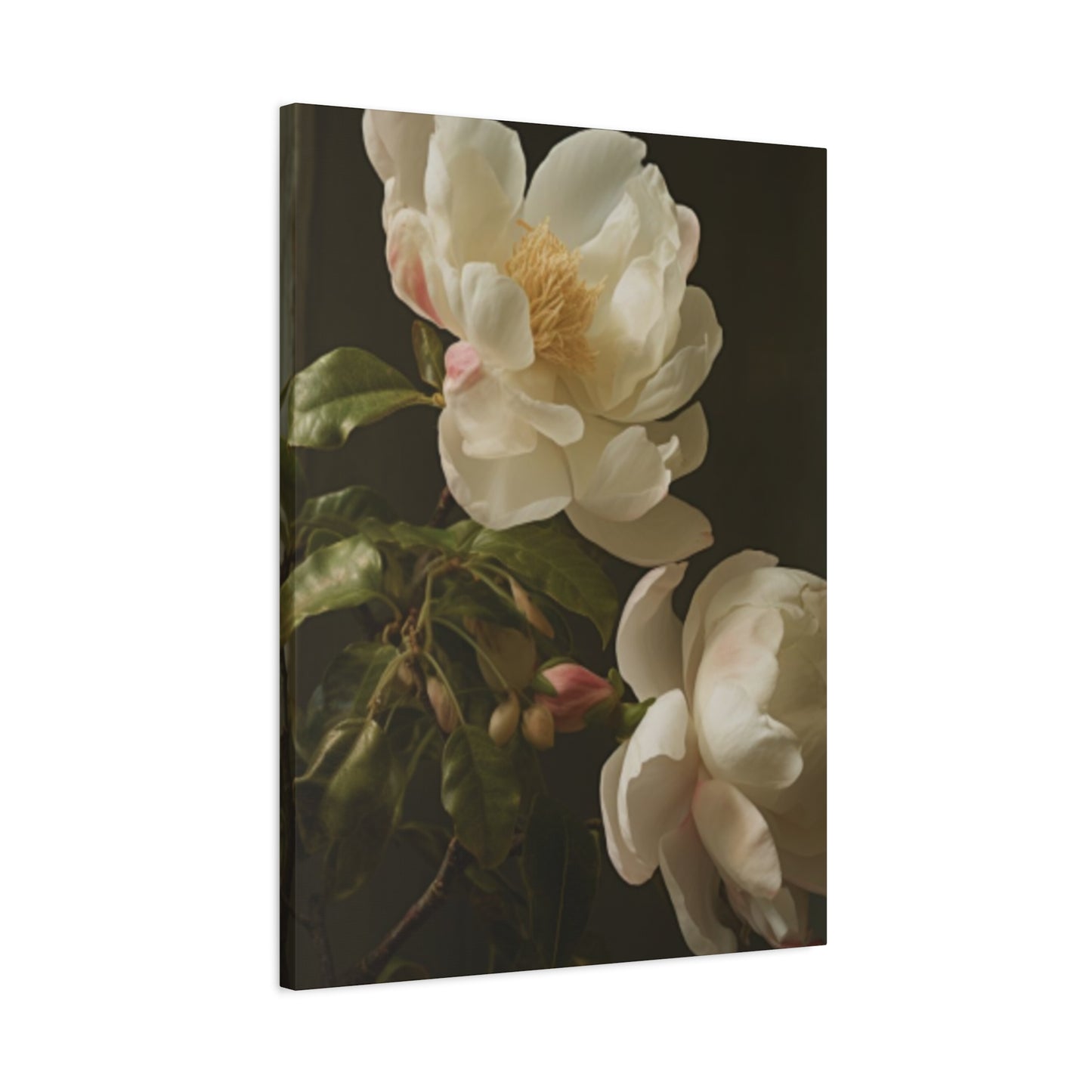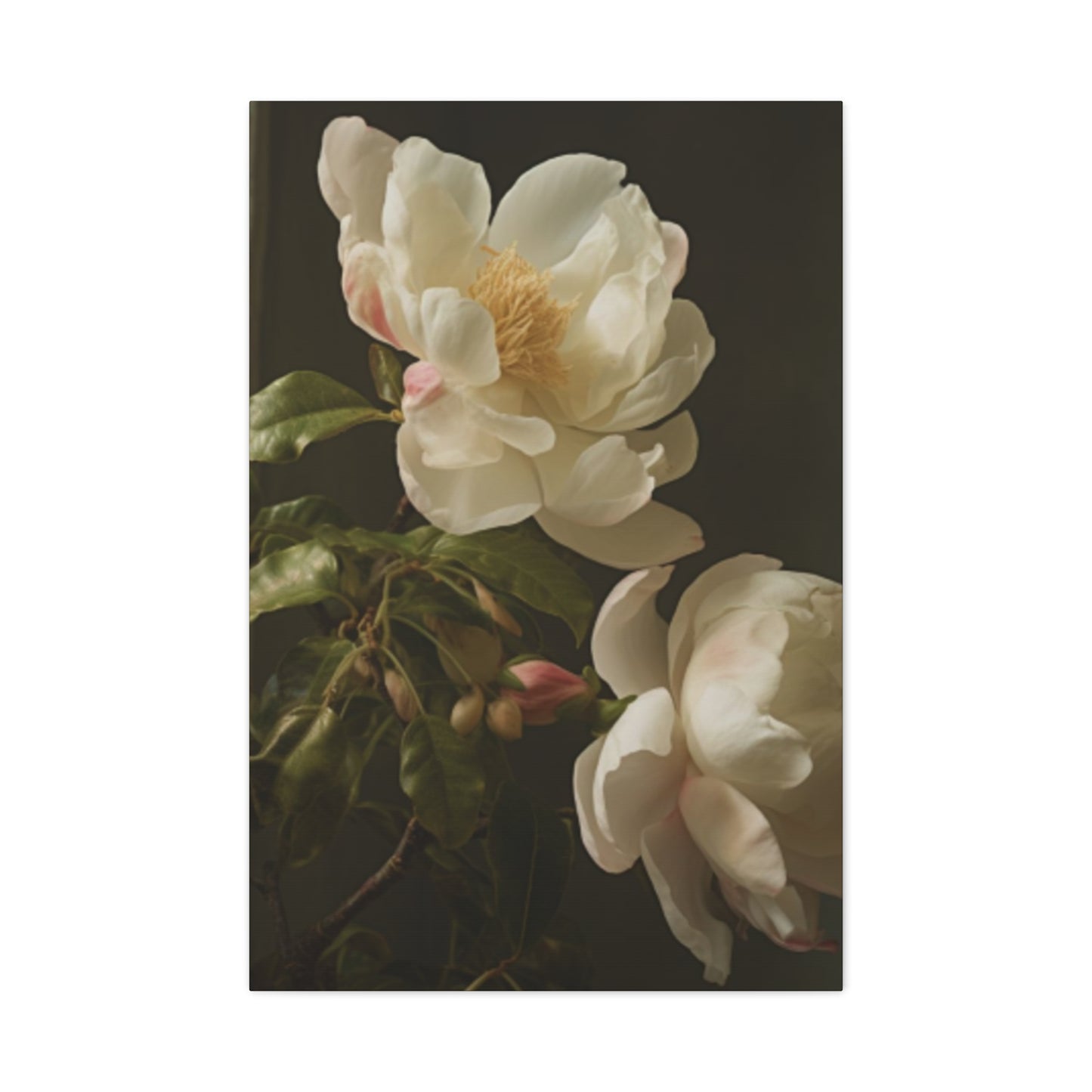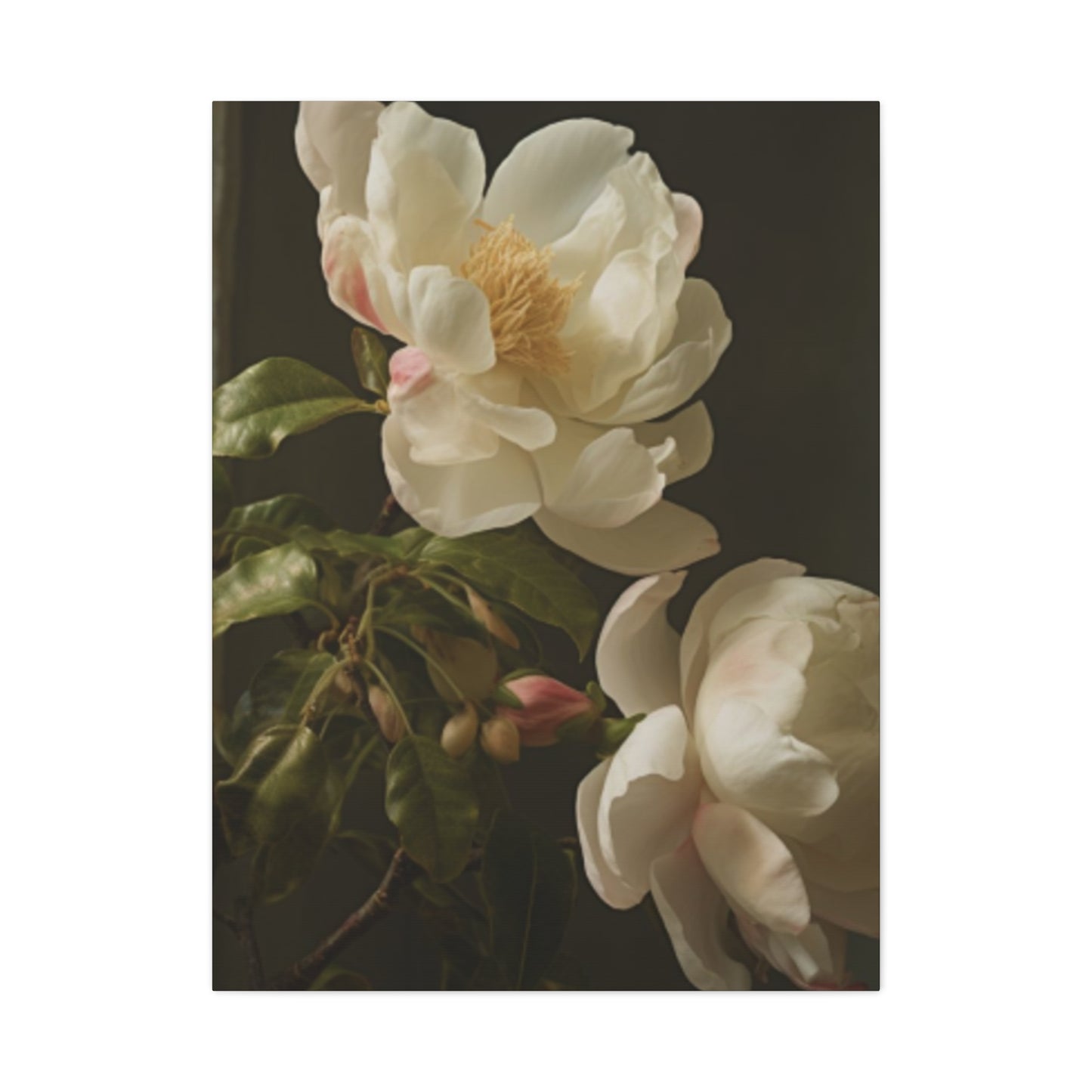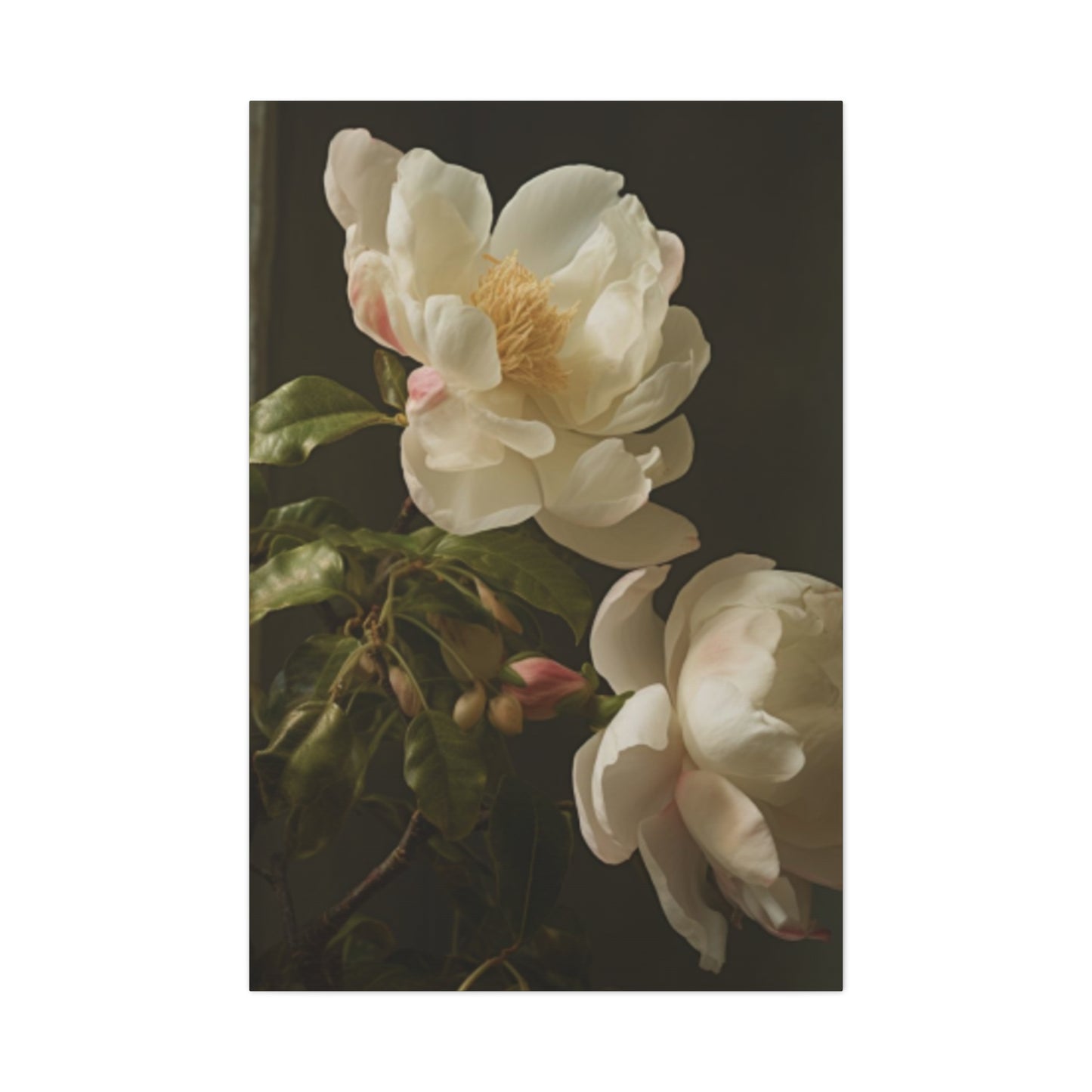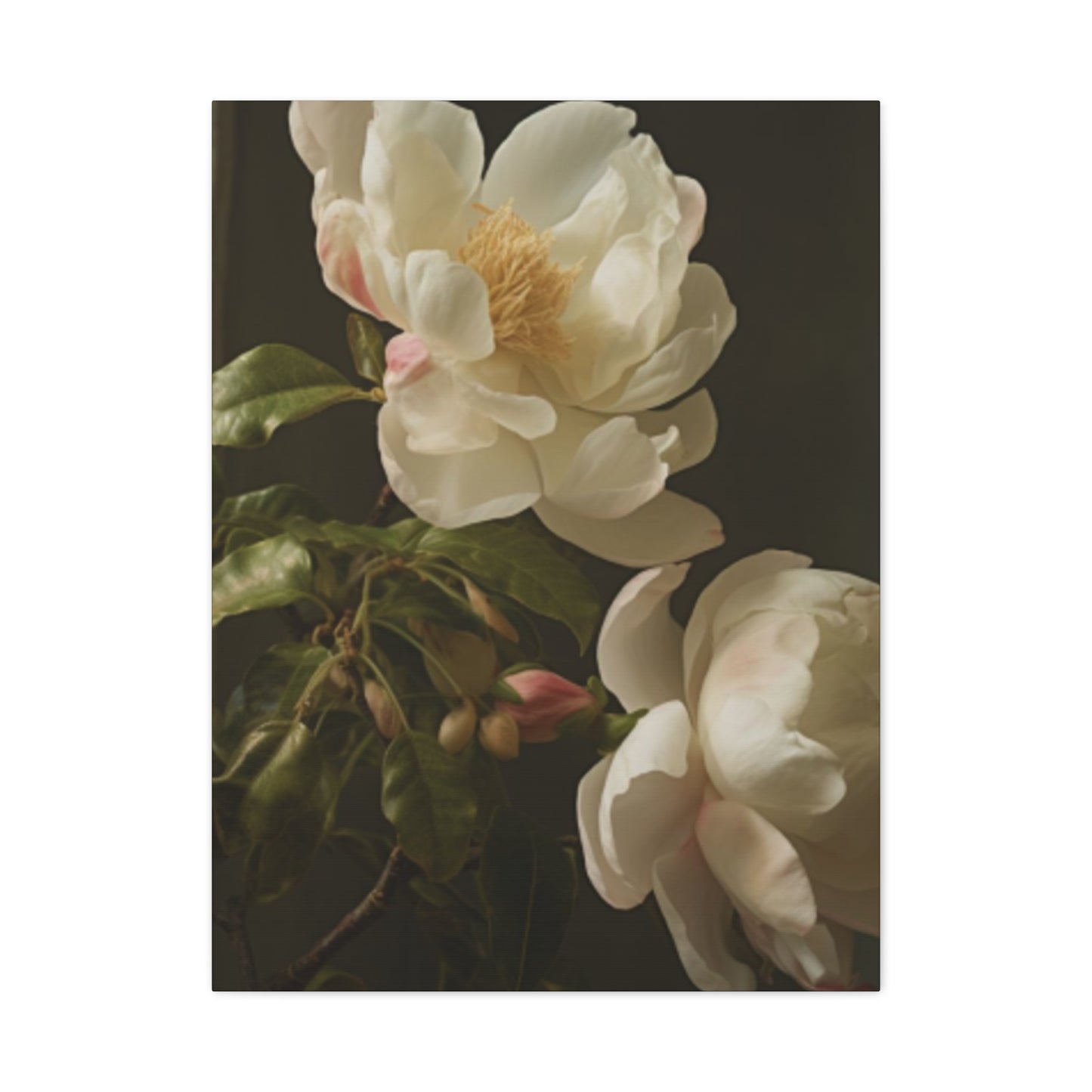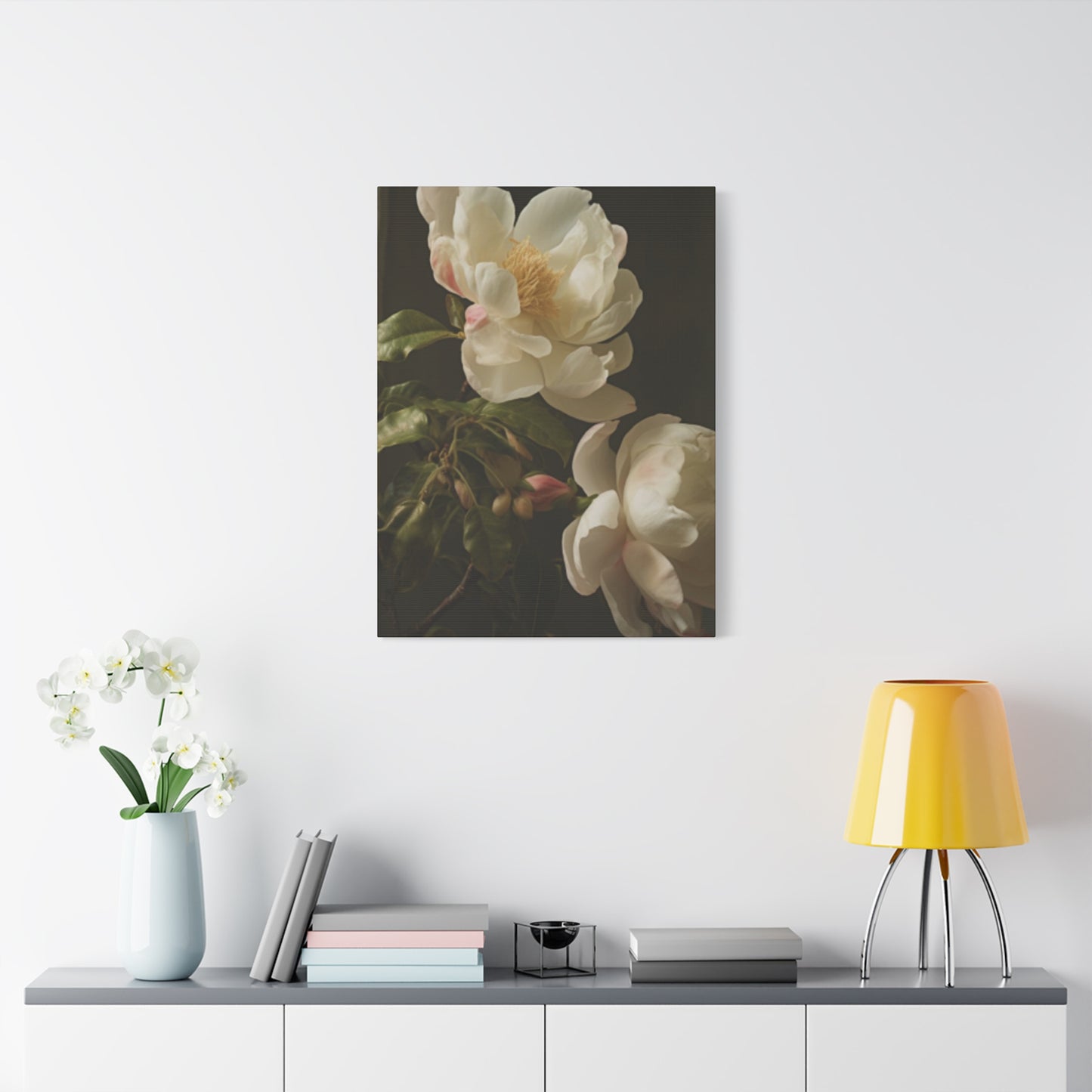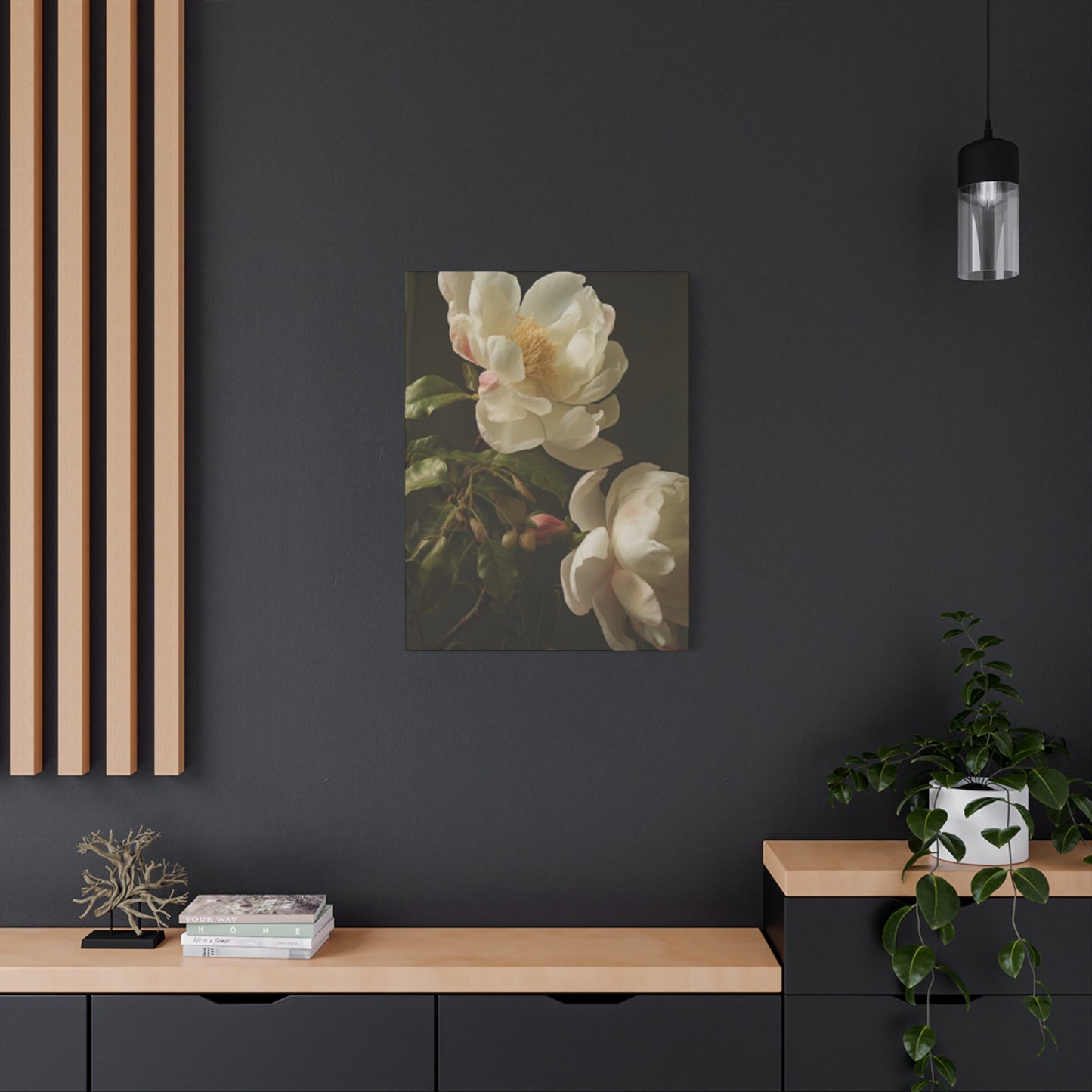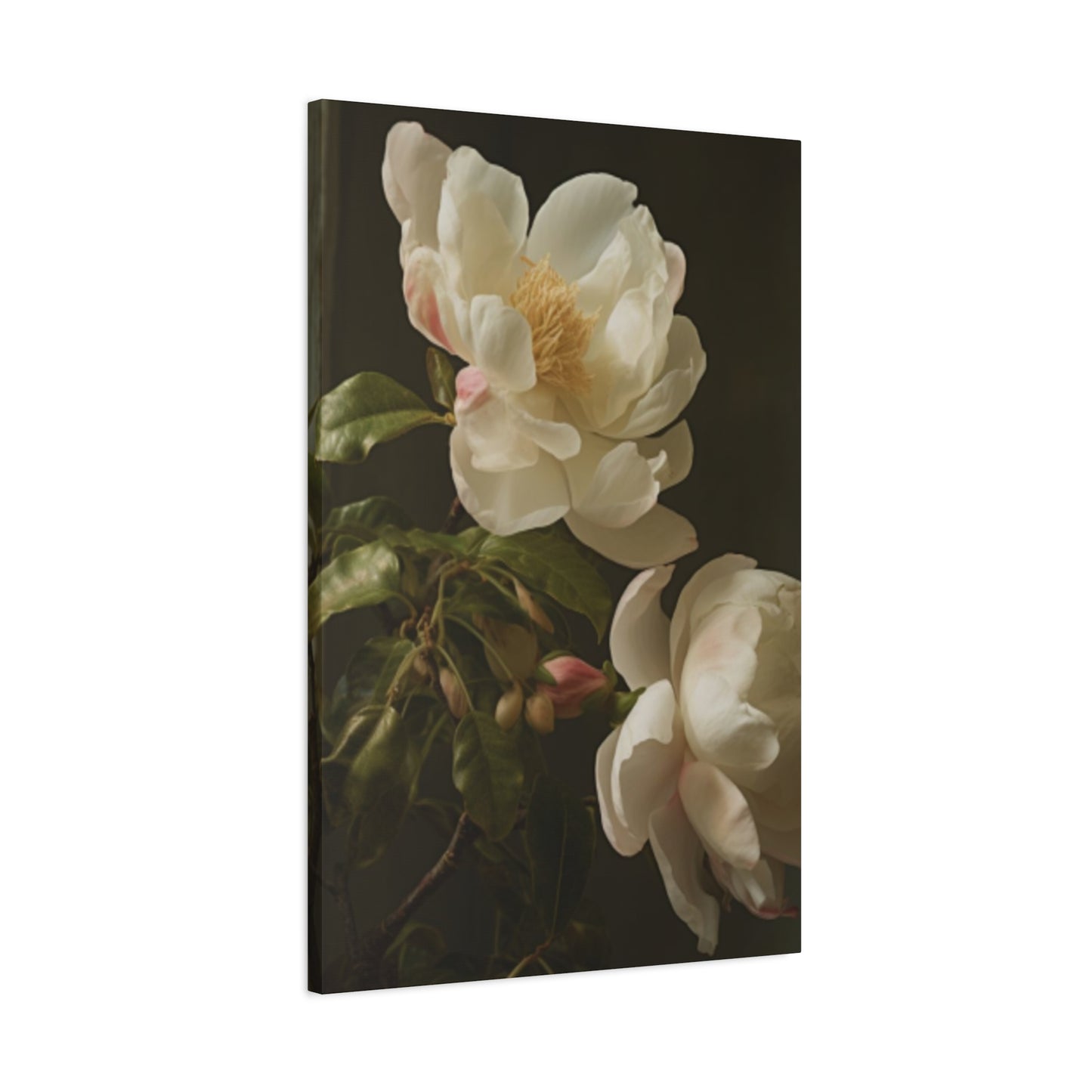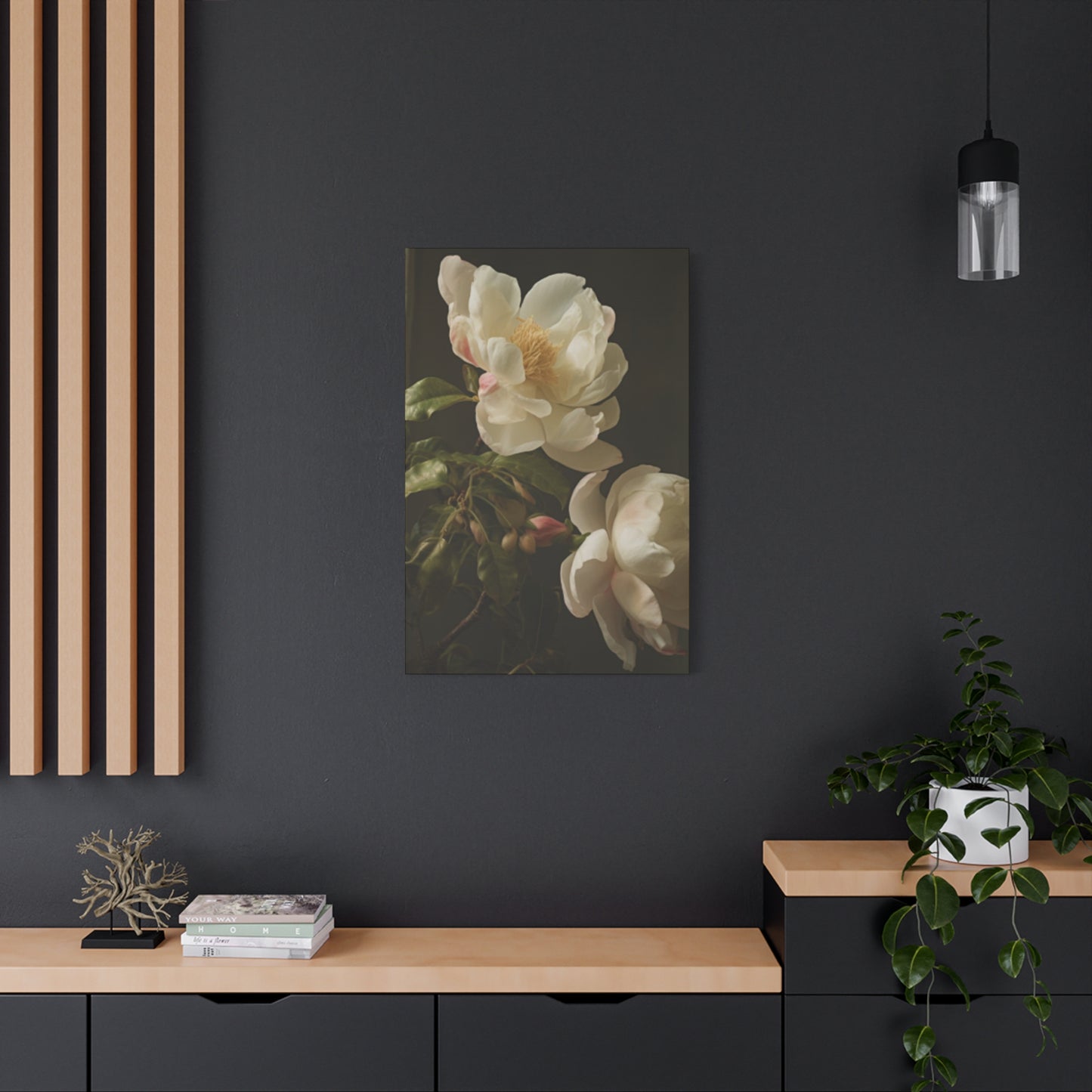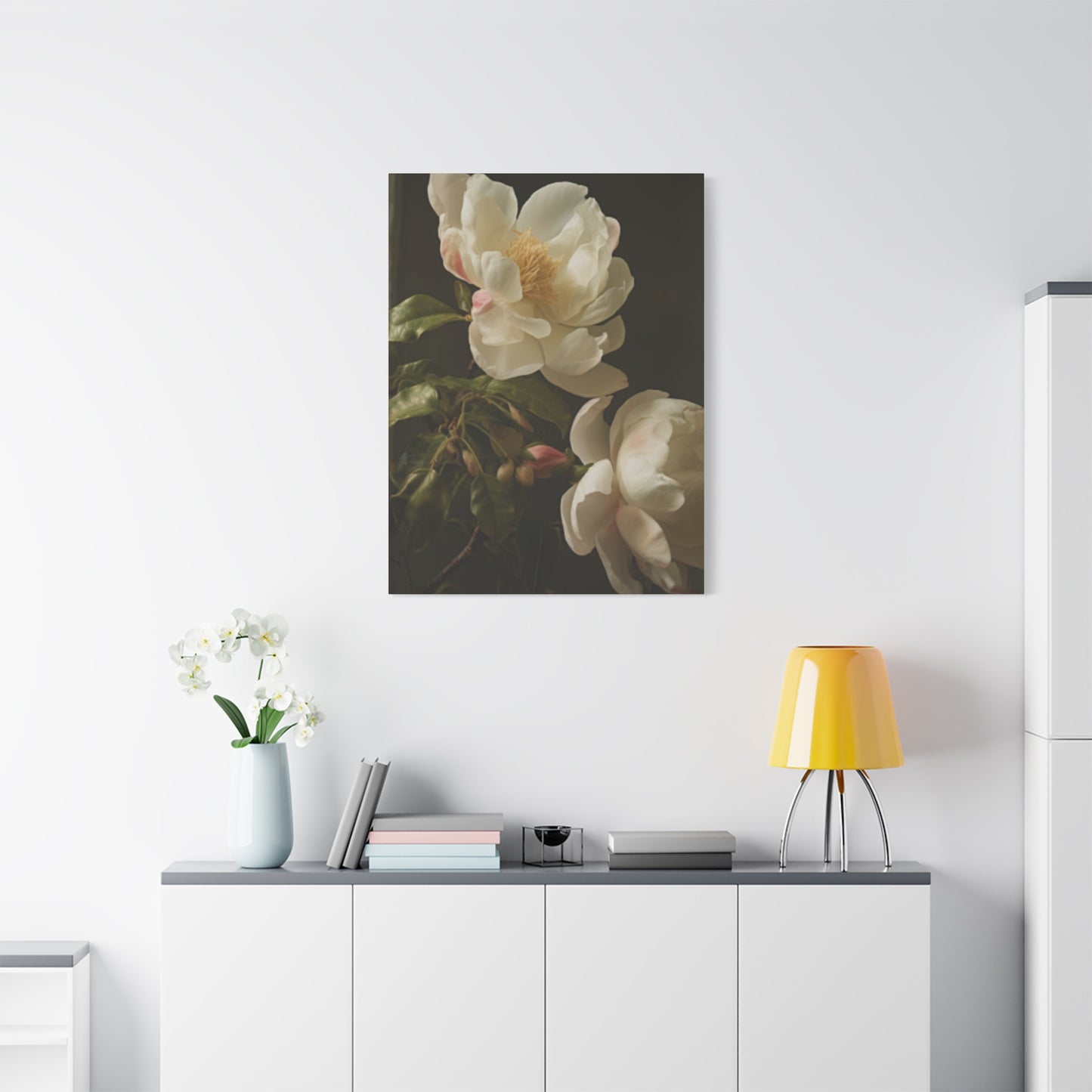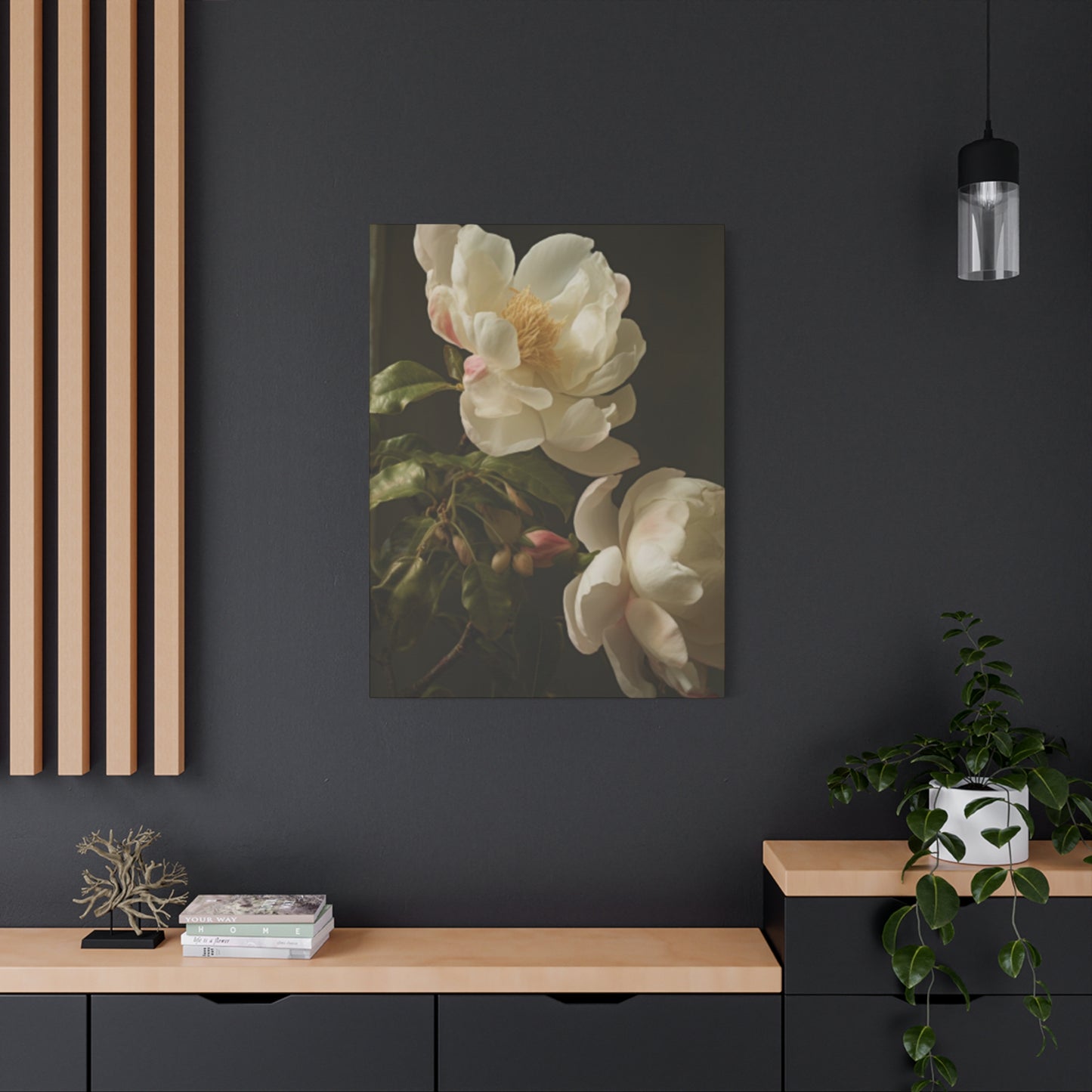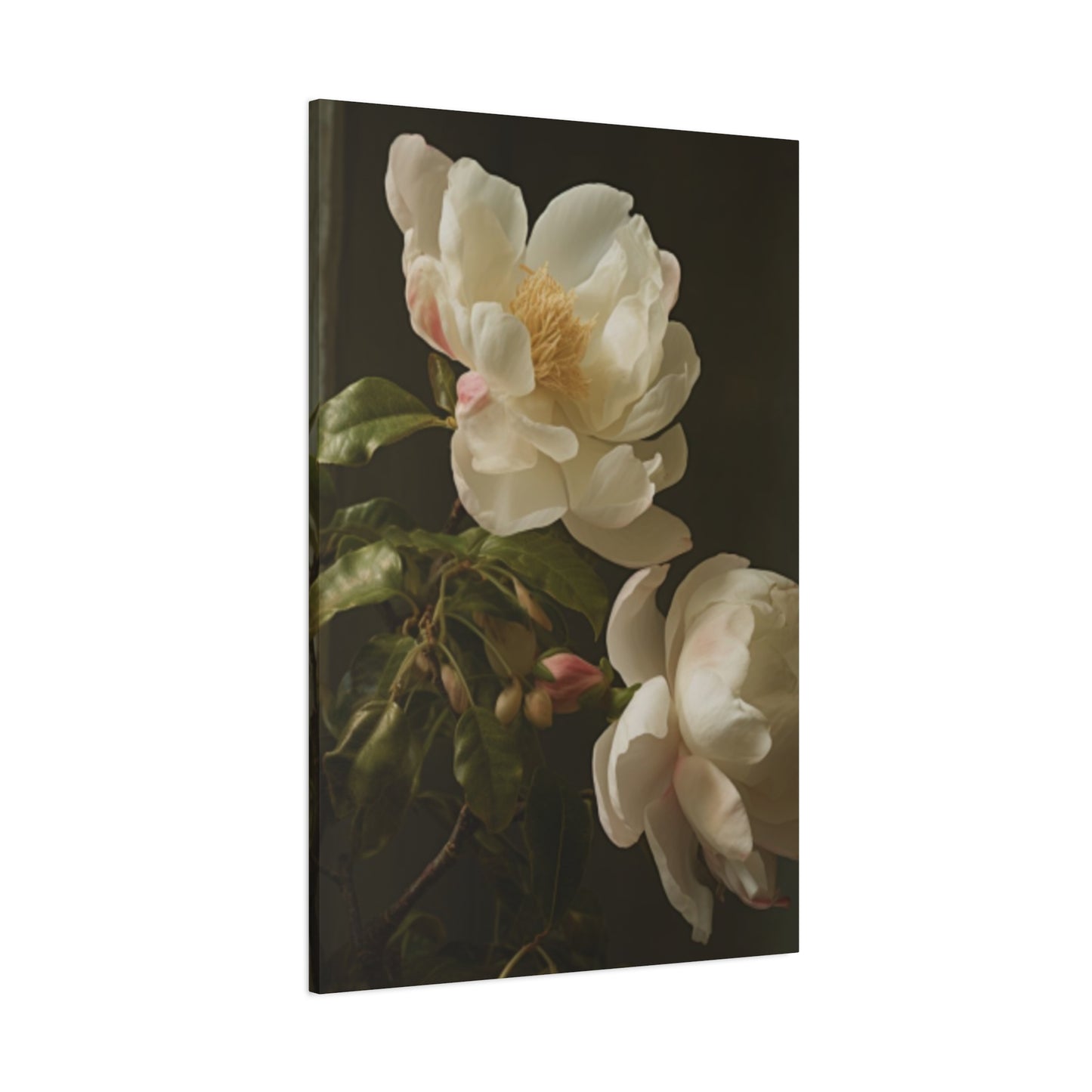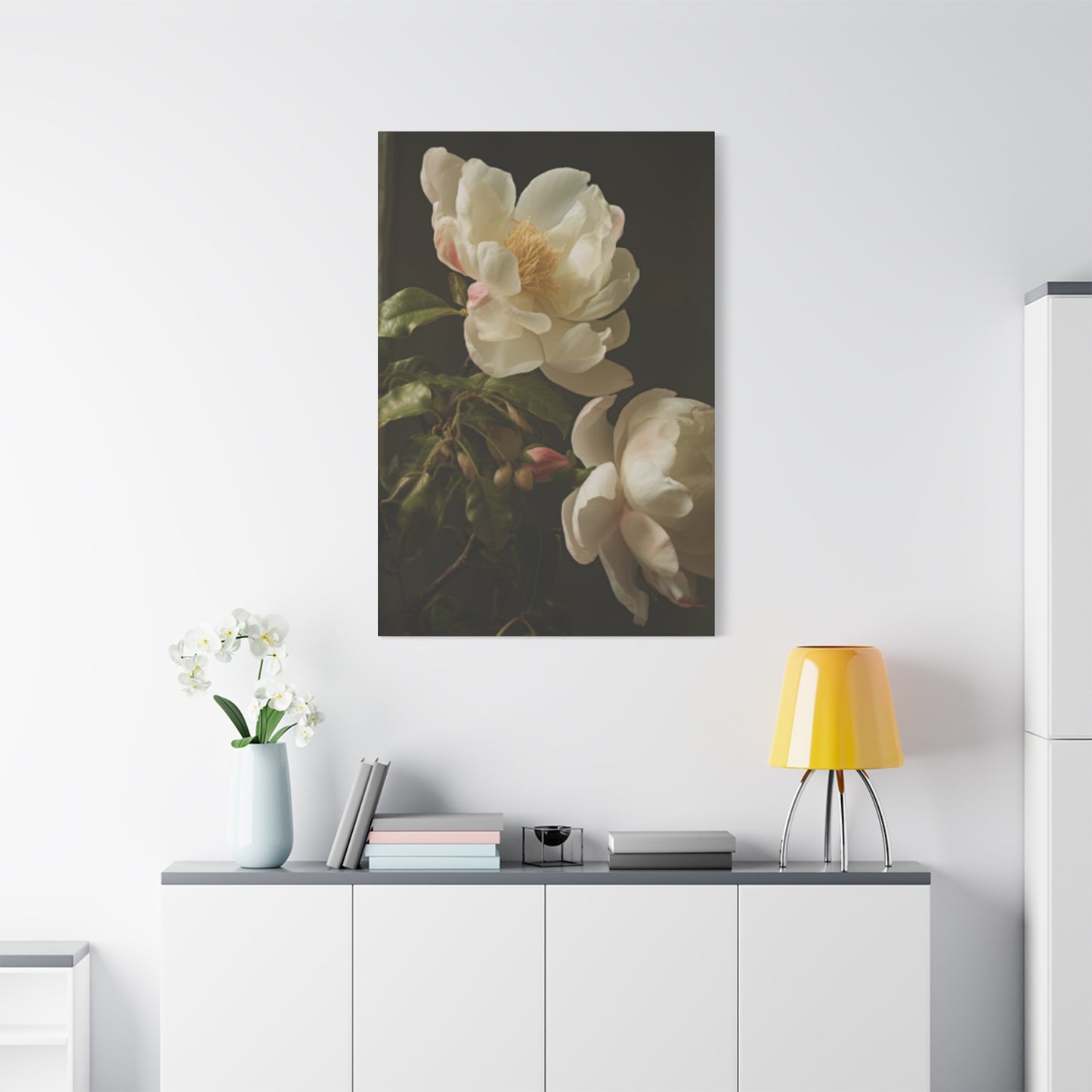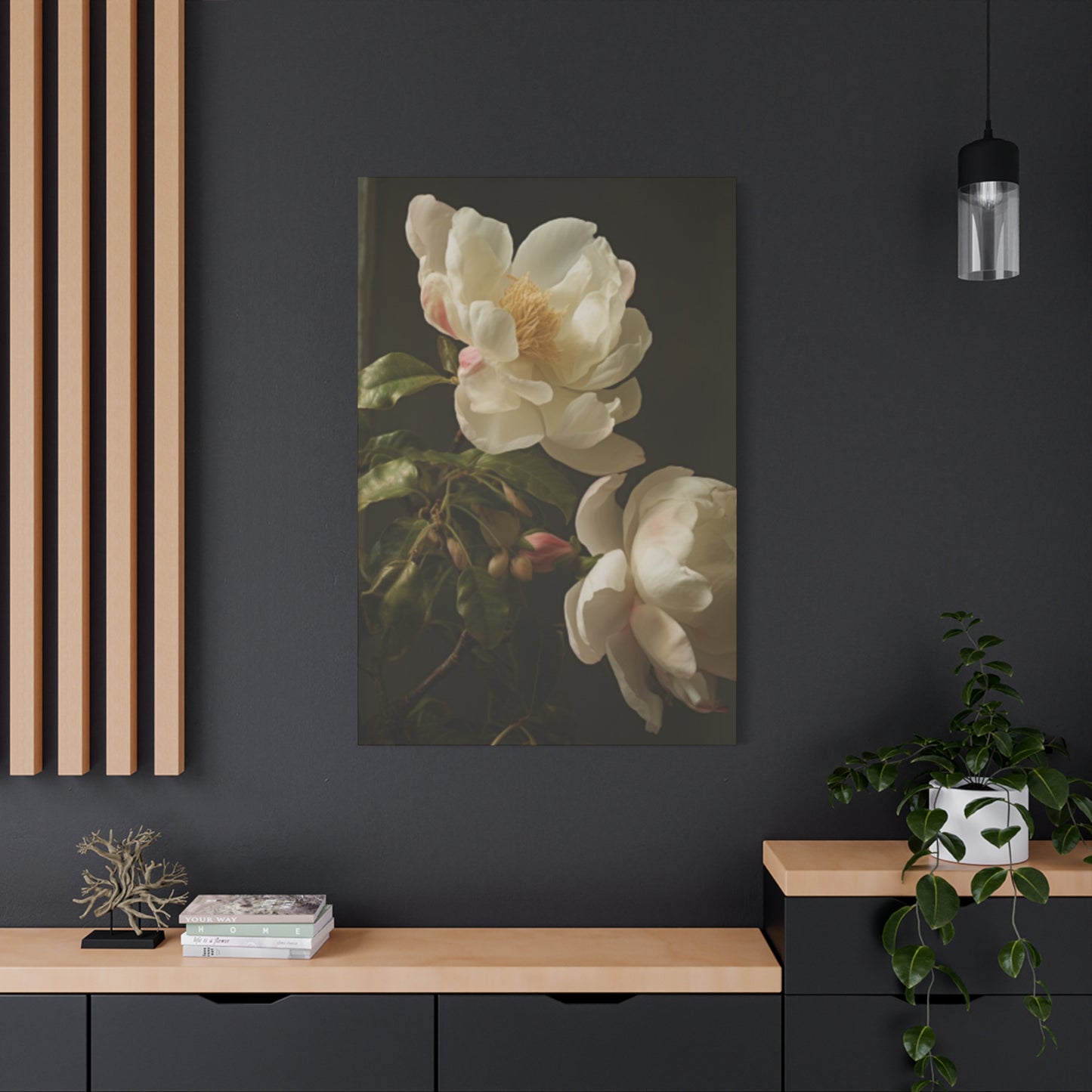White Magnolia Bloom on Dark Background Wall Art: Modern Contrast for Elegant Homes
The aesthetic appeal of floral imagery presented in reverse tonality has captured the attention of interior designers and homeowners seeking sophisticated wall decoration solutions. Magnolia blossoms rendered in pale tones against dark surfaces create an arresting visual contrast that commands attention while maintaining an air of refined elegance. This particular approach to botanical artwork represents a departure from conventional colorful floral presentations, offering instead a dramatic and timeless quality that adapts seamlessly to various decorative schemes.
The magnolia flower itself carries centuries of symbolic significance across multiple cultures, representing nobility, perseverance, and natural beauty. When this meaningful bloom is captured in a stark monochromatic palette with reversed values, the resulting artwork transcends mere decoration to become a statement piece that reflects both contemporary taste and classical appreciation for nature's forms. The interplay between light and shadow, positive and negative space, and the inherent sculptural qualities of magnolia petals become amplified when stripped of color and presented against an obsidian backdrop.
Contemporary living spaces increasingly favor design elements that balance boldness with subtlety, and floral artwork featuring pale blooms on dark surfaces perfectly satisfies this aesthetic requirement. These pieces function as visual anchors within rooms, drawing the eye without overwhelming other decorative elements. The versatility of this artistic approach allows it to complement minimalist interiors while also providing sophisticated counterpoint in more traditionally furnished spaces.
The Aesthetic Power of Reversed Contrast in Botanical Artwork
The decision to present pale magnolia blossoms against dark backgrounds represents more than a simple color inversion. This artistic choice fundamentally alters how viewers perceive and interact with the floral subject matter. Traditional botanical illustrations typically feature colorful blooms against light or neutral backgrounds, allowing the flowers to project forward visually. Reversing this arrangement creates an entirely different spatial relationship where the blossoms appear to emerge from or float within the darkness, generating a sense of mystery and depth.
This contrast-reversal technique has historical precedents in various artistic traditions, from Japanese ink paintings to early photographic negatives. Artists have long recognized that presenting light subjects against dark fields creates heightened drama and focuses attention on the illuminated elements. In the context of magnolia flower artwork, this approach emphasizes the delicate petal structure, the graceful curves of the bloom, and the subtle variations in tone that might otherwise go unnoticed.
The psychological impact of viewing pale forms against dark backgrounds differs significantly from the conventional arrangement. Dark backgrounds tend to recede visually, creating the illusion that illuminated subjects float in undefined space. This quality lends an almost ethereal character to magnolia blossoms presented in this manner, transforming them from mere botanical subjects into contemplative focal points that invite extended viewing and reflection.
From a technical standpoint, dark backgrounds also serve practical purposes in residential and commercial settings. They are less likely to show wear, fingerprints, or minor damage compared to light-colored artworks. This durability factor makes them particularly suitable for high-traffic areas or spaces where maintenance considerations influence decorative choices. Additionally, the dark field provides a visually restful quality that can help balance rooms with abundant natural light or multiple bright elements.
Magnolia Symbolism Throughout Cultural Contexts
The magnolia flower carries layered meanings that vary across different cultural traditions, adding depth to artwork featuring these blooms. In Chinese culture, magnolias have been celebrated for centuries as symbols of feminine beauty and gentleness. Ancient Chinese poets frequently referenced magnolia blossoms in their verses, associating them with purity and nobility. The flower's appearance in early spring, often before other blooms emerge, also connects it to themes of perseverance and the ability to thrive despite challenging conditions.
Southern United States culture has adopted the magnolia as an enduring symbol of the region itself, representing hospitality, dignity, and the graceful qualities associated with Southern tradition. The magnolia's presence in literature, music, and visual arts from this region reflects its deep integration into the cultural identity of these states. Magnolia trees themselves are long-lived and resilient, qualities that resonate with themes of endurance and steadfastness.
In Victorian flower language, magnolias conveyed messages of nobility and love of nature. The impressive size of magnolia blooms and their striking appearance made them particularly valued in floral arrangements meant to convey significant sentiments. This historical association with meaningful communication adds an additional layer of significance to contemporary magnolia artwork, connecting modern decorative choices with long-standing traditions of symbolic expression.
Asian cultures beyond China also recognize magnolia significance, with Korean traditions associating the flower with purity and Japanese aesthetics celebrating its brief but spectacular blooming period as a reminder of life's transience. This connection to impermanence and the appreciation of fleeting beauty aligns with broader philosophical concepts about mindfulness and presence. Artwork featuring magnolia blossoms can therefore serve as visual reminders of these deeper philosophical considerations.
The magnolia's botanical characteristics also contribute to its symbolic resonance. These flowers bloom on bare branches before leaves appear, creating a striking visual display that represents renewal and the cyclical nature of existence. The substantial petals and pronounced form of magnolia blossoms distinguish them from more delicate flowers, suggesting strength combined with beauty. When captured in artwork, particularly in high-contrast presentations against dark backgrounds, these qualities become even more pronounced and meaningful.
Design Versatility in Various Interior Settings
Artwork featuring pale magnolia blossoms on dark backgrounds demonstrates remarkable adaptability across diverse interior design styles. In minimalist spaces characterized by clean lines, neutral palettes, and uncluttered surfaces, this type of artwork provides a sophisticated focal point without introducing visual chaos. The simplified color scheme of the artwork aligns with minimalist principles while the organic forms of the magnolia introduce natural elements that soften the potentially stark quality of minimalist interiors.
Contemporary and modern interiors, which often feature bold contrasts and geometric elements, benefit from the organic counterpoint that floral imagery provides. The curved petals and flowing lines of magnolia blossoms create visual relief from angular furniture and architectural features. When presented against dark backgrounds, these botanical subjects maintain sufficient visual weight to hold their own alongside strong contemporary design elements without appearing overly delicate or incongruous.
Traditional and transitional spaces gain renewed energy from the inclusion of monochromatic floral artwork. Rather than competing with established decorative elements like patterned textiles, ornate furniture, or detailed architectural features, the simplified palette of pale-on-dark magnolia art provides visual breathing room. This artwork style bridges traditional appreciation for botanical subjects with contemporary aesthetic sensibilities, making it particularly effective in transitional design schemes that blend old and new.
Industrial-style interiors, characterized by exposed brick, metal fixtures, and raw materials, find an unexpected but effective partner in refined floral artwork. The contrast between rough industrial surfaces and the delicate beauty of magnolia blossoms creates compelling visual tension that enlivens these spaces. The dark background of the artwork relates to the often-dark tones present in industrial design while the pale blooms introduce softness without compromising the overall aesthetic direction.
Scandinavian design, with its emphasis on natural materials, functional beauty, and restrained color palettes, naturally accommodates monochromatic botanical artwork. The appreciation for nature that underpins Scandinavian design philosophy finds expression in floral subjects, while the simplified color treatment aligns with the style's preference for visual clarity. Dark-background magnolia artwork can serve as the singular bold element in predominantly light Scandinavian interiors, creating the intentional focal point that prevents these spaces from feeling bland.
Bohemian and eclectic interiors, while typically more colorful and varied, can also incorporate dark-background floral artwork effectively. In these settings, such pieces provide visual grounding amid diverse decorative elements. The monochromatic quality of the artwork offers a place for the eye to rest within busier surroundings, while the recognizable floral subject maintains connection to the natural world that bohemian styles typically celebrate.
Lighting Considerations for Maximum Visual Impact
Proper illumination significantly enhances artwork featuring pale magnolia blossoms on dark backgrounds, and lighting design deserves careful attention during installation. The high contrast nature of this artwork style means that lighting affects its appearance more dramatically than it would for pieces with more uniform tonality. Strategic lighting can transform the artwork from a static wall decoration into a dynamic focal point that changes character throughout the day and evening.
Natural daylight reveals the subtle tonal variations within both the pale blooms and the dark background, providing the most accurate representation of the artwork's qualities. Positioning artwork on walls that receive indirect natural light allows these subtleties to emerge without the complications of direct sunlight, which can cause glare, washing out the delicate tones of the flowers. North-facing walls in the northern hemisphere receive consistent, cool light throughout the day, making them ideal locations for artwork when available.
Artificial lighting offers control over how artwork appears, allowing for dramatic evening presentations that differ from daytime viewing. Picture lights, either battery-operated or hardwired, provide focused illumination from above or below the artwork. For pale blooms on dark backgrounds, lighting from above mimics natural light conditions and emphasizes the white flowers, making them appear to glow against the dark field. The concentrated light also creates subtle shadows and highlights that add dimension to the viewing experience.
Recessed ceiling spotlights offer flexible illumination options, particularly when installed on dimmer switches that allow adjustment of intensity. Multiple spotlights can create even illumination across large-format artwork or dramatic highlighting of specific areas. The adjustable nature of many recessed fixtures permits precise aiming to eliminate glare on glossy surfaces while maximizing the visual impact of the contrast between light and dark areas.
Track lighting provides similar flexibility with easier installation, as it doesn't require ceiling modifications. Modern track systems offer sophisticated aesthetic options beyond the industrial appearance of older designs, making them suitable for contemporary residential installations. The ability to adjust individual fixture positions along the track allows for experimentation with lighting angles and combinations to achieve optimal presentation.
Ambient room lighting influences how artwork appears when not directly illuminated. Rooms with warm-toned artificial light will cast slight yellow or orange tints on white areas of the artwork, while cool-toned lighting preserves or enhances the pure white quality of the magnolia blooms. LED technology offers precise color temperature control, allowing selection of lighting that either warms or cools the overall space while considering how it affects artwork appearance.
Avoiding common lighting mistakes preserves both the artwork itself and the quality of its presentation. Direct sunlight should never fall on artwork, as UV radiation causes fading and degradation even in fade-resistant prints and when protective glass or acrylic covers are present. Excessive heat from lighting fixtures positioned too close to artwork can also cause damage, particularly to canvas and photographic prints. Maintaining distance and using LED fixtures that generate minimal heat prevents these issues.
Creating Gallery Wall Arrangements with Magnolia Artwork
Incorporating pale magnolia blossom artwork into multi-piece gallery wall arrangements requires thoughtful planning to achieve visual coherence while maintaining interest. The high contrast nature of this artwork style makes it a strong candidate for serving as the anchor or focal point within larger arrangements. Its graphic quality holds its own alongside other artwork types, while the recognizable floral subject matter provides accessible imagery that balances more abstract or challenging pieces.
Monochromatic gallery walls featuring exclusively black and white imagery create sophisticated, cohesive presentations. Combining magnolia blossom artwork with other botanical subjects, architectural photography, or abstract graphics in similar tonal ranges produces unified walls that make strong visual statements. This approach works particularly well in modern and contemporary spaces where color restraint contributes to the overall design philosophy. The variety in subject matter prevents monotony while the consistent palette maintains harmony.
Mixed gallery walls that include color alongside black and white pieces can successfully incorporate magnolia artwork if color selections are intentional rather than random. Limiting color to specific tones, perhaps only warm or only cool hues, helps integrate colored pieces with monochromatic magnolia art. Alternatively, using the magnolia pieces as consistent elements that appear multiple times within the arrangement provides visual rhythm that unifies diverse images.
Size variation within gallery arrangements prevents the static quality that can result from uniform dimensions. Combining a large-scale magnolia piece with several smaller complementary images creates hierarchy and guides viewer attention. The larger magnolia artwork naturally becomes the focal point, while smaller surrounding pieces provide supporting visual interest. This approach mimics the way eyes naturally move through visual fields, starting with dominant elements before exploring details.
Geometric arrangement patterns bring structure to gallery walls that might otherwise appear chaotic. Grid layouts with consistent spacing between pieces create orderly, calm presentations suitable for formal spaces or minimalist interiors. Asymmetrical arrangements with varied spacing introduce dynamic energy appropriate for casual living areas or creative work spaces. The pale-on-dark magnolia artwork can anchor either arrangement type, providing a visual weight that grounds surrounding pieces.
Vertical or horizontal emphasis in arrangements should respond to both the space itself and the individual artworks' orientations. Rooms with high ceilings benefit from vertical gallery arrangements that draw the eye upward and make use of available wall height. Horizontal arrangements suit spaces above sofas, beds, or other furniture pieces, creating visual width that complements the furniture's horizontal lines. Magnolia artwork in complementary orientation can either reinforce or provide contrast to the overall directional emphasis.
Spacing between individual pieces affects how the arrangement reads as unified or separate. Closer spacing, typically two to three inches between frames, creates cohesive groupings that function as single large-scale visual elements. Wider spacing maintains the individual identity of each piece while still relating them as intentional collections. For arrangements including the strong contrast of pale magnolia on dark backgrounds, slightly wider spacing may prevent visual intensity from becoming overwhelming.
Historical Perspectives on Floral Art in Domestic Settings
The tradition of displaying floral imagery within homes extends across centuries and cultures, reflecting humanity's enduring connection to botanical beauty. Ancient civilizations incorporated floral motifs into wall paintings, mosaics, and tapestries, bringing natural beauty into built environments. Roman villas featured extensive botanical frescoes depicting gardens and individual flower species with remarkable detail, demonstrating sophisticated appreciation for decorative florals long before modern printing technologies.
Medieval and Renaissance European traditions maintained floral artistic presence through illuminated manuscripts, tapestries, and early easel paintings. The symbolic language of flowers became increasingly refined during these periods, with specific blooms carrying defined meanings that educated viewers recognized. Religious art frequently incorporated floral elements laden with theological significance, while secular botanical art emerged as natural philosophy developed scientific approaches to plant study.
The Dutch Golden Age of the seventeenth century elevated floral painting to unprecedented levels of technical achievement and cultural importance. Master painters created elaborate still-life compositions featuring multiple flower species arranged in spectacular displays. These paintings served multiple purposes beyond mere decoration, functioning as demonstrations of artistic skill, symbols of wealth and cultivation, and even memento mori reminders of life's transience. The detailed realism of these works influenced botanical art traditions that continue to present day.
Eighteenth and nineteenth century European and American homes of sufficient means featured botanical prints, watercolors, and oil paintings as standard decorative elements. The Victorian era particularly emphasized floral decoration, with wallpapers, textiles, and artwork all incorporating abundant botanical imagery. This period codified the language of flowers into widely understood systems where bouquets and floral images communicated specific sentiments. The popularity of botanical art during this era reflected both aesthetic preferences and the scientific interest in botany that characterized the period.
The Arts and Crafts movement of the late nineteenth and early twentieth centuries renewed emphasis on nature-inspired decoration as reaction against industrial standardization. William Morris and associated designers created influential patterns featuring stylized flowers and plants, arguing for the spiritual and aesthetic value of natural forms in living spaces. This philosophical approach to botanical decoration influenced subsequent design movements and established principles that remain relevant in contemporary practice.
Modernist movements of the twentieth century temporarily reduced emphasis on representational botanical art, favoring abstraction and non-representational forms. However, botanical subjects never disappeared entirely, and the latter decades of the century witnessed renewed appreciation for floral imagery in both traditional and contemporary presentations. This resurgence reflected broader environmental awareness and desire to maintain connections with nature in increasingly urbanized societies.
Contemporary approaches to floral wall art demonstrate unprecedented diversity, from photographic realism to extreme abstraction, from traditional color palettes to unexpected treatments like pale blossoms on dark backgrounds. Current trends favor artistic interpretation over strictly scientific representation, allowing creative freedom while maintaining recognizable connection to natural subjects. The availability of high-quality reproduction technologies has democratized access to botanical artwork, making sophisticated floral wall decoration available across economic segments.
Botanical Accuracy Versus Artistic Interpretation
Creators of magnolia blossom artwork face fundamental choices regarding the degree of botanical accuracy to pursue versus the extent of artistic license to employ. These decisions significantly affect the final artwork's character and appropriate applications. Scientifically accurate botanical illustration serves educational functions and appeals to viewers interested in precise representations of plant species, while more interpretive approaches prioritize aesthetic qualities and emotional impact over documentation.
Traditional botanical illustration developed as scientific discipline, with artists working alongside botanists to create detailed, accurate representations of plant species. These illustrations adhered to strict conventions regarding perspective, lighting, and compositional structure to serve their primary function as scientific documentation. The accuracy requirements produced distinctive aesthetic characteristics that continue to influence contemporary botanical art even when scientific purpose no longer drives creation.
Photographic magnolia artwork occupies a middle ground between strict botanical illustration and free artistic interpretation. Photography necessarily creates accurate representations of actual magnolia blooms, capturing real petal arrangements, authentic coloration, and genuine structural details. However, photographers exercise extensive creative control through composition, lighting, focus, and post-processing decisions that move the results beyond pure documentation toward artistic expression.
Digital manipulation of magnolia images allows virtually unlimited artistic interpretation while beginning with photographed reality. Artists can enhance contrast, adjust colors into monochromatic schemes, add textures, simplify forms, or combine multiple images into impossible arrangements that never existed in nature. These digitally interpreted pieces bridge botanical and abstract art, maintaining recognizable floral subjects while pursuing purely aesthetic goals rather than representational accuracy.
Painted or drawn magnolia artwork offers greatest interpretive freedom, as artists work from imagination, memory, or reference materials rather than capturing actual specimens. The medium itself, whether watercolor, oil, charcoal, or digital painting, influences the result's character. Painted magnolia art can range from near-photographic realism to loose, gestural suggestions of floral forms, with each approach creating different viewer experiences and suiting different interior design applications.
Stylized magnolia artwork emphasizes decorative qualities over botanical precision, often simplifying forms, exaggerating features, or incorporating design elements that enhance visual appeal at the expense of accuracy. Patterns might repeat magnolia motifs in ways that create rhythm and movement rather than depicting how flowers actually grow. Color treatments might abandon natural hues entirely in favor of palettes chosen for aesthetic effect, as seen in pale-on-dark presentations that reverse natural appearance.
The choice between accuracy and interpretation should align with the artwork's intended setting and purpose. Spaces with educational functions or scientific connections benefit from more accurate botanical approaches. Creative studios, contemporary galleries, and modern homes often prefer interpretive treatments that emphasize artistic vision. Traditional interiors might split between these approaches, with formal spaces leaning toward botanical accuracy and casual areas accommodating greater artistic freedom.
Installation Best Practices and Technical Considerations
Proper installation of magnolia blossom artwork ensures both security and optimal presentation while protecting walls and the artwork itself. The installation approach should match the artwork's size, weight, and format, with different hanging methods appropriate for different situations. Professional-quality installation produces better results than hasty improvisation, making the effort invested in correct techniques worthwhile.
Picture hanging hardware selection depends primarily on artwork weight and wall type. Standard gypsum drywall requires different fasteners than plaster, brick, or concrete. For lightweight pieces under ten pounds, standard picture hangers with nails provide sufficient support. Medium-weight artworks between ten and twenty-five pounds require more substantial hardware such as wall anchors or molly bolts that distribute weight more effectively. Heavy pieces exceeding twenty-five pounds demand robust mounting systems, potentially including wall studs or specialized heavy-duty hardware.
Wire hanging systems offer flexibility and professional results for medium to large artworks. Picture wire attached to D-rings or hanging hardware on the frame back allows horizontal position adjustment without reinstalling wall hardware. The wire should be strong enough to support several times the artwork's actual weight, providing safety margin. Pulling the wire taut from both sides to form a V-shape provides stable hanging geometry that resists tilting.
Height placement significantly affects viewing experience and spatial perception. The standard guideline positions artwork centers at fifty-seven to sixty inches from the floor, approximating average eye level in standing position. However, this rule requires adjustment based on ceiling height, furniture presence, and viewer expectations. Above sofas and beds, maintaining six to twelve inches of space between furniture top and artwork bottom creates appropriate visual separation while establishing clear relationship between elements.
Level installation prevents the unprofessional appearance of crooked artwork and ensures proper visual perception. Using quality levels during installation eliminates guesswork and produces reliably straight results. For multiple-piece arrangements, establishing level reference lines with painter's tape before installing any pieces ensures proper alignment throughout the grouping. Laser levels provide efficient solutions for large installations or gallery wall arrangements with multiple components requiring precise coordination.
Wall preparation prevents damage and ensures clean results. Locating wall studs before installation allows strategic placement of heavy pieces on these structural supports. Stud finders reliably identify stud locations behind finished walls, though manual techniques like knocking and listening for solid versus hollow sounds also work. Marking stud locations with light pencil marks that will hide behind artwork prevents repeated searching during installation process.
Protecting walls during installation prevents scratches, dents, and marks that require later repair. Using proper drilling techniques with appropriate bits matched to wall material creates clean holes without excessive damage. Placing tape over drill locations before drilling reduces wall surface cracking. For temporary installations or rental situations, adhesive hanging strips provide damage-free alternatives that support surprising weight capacities when properly applied.
Artwork spacing in multi-piece arrangements requires mathematical planning for balanced results. Calculating total wall width, subtracting combined artwork widths, then dividing remaining space by the number of gaps between pieces yields equal spacing measurements. Adding an additional gap for margins on both ends of the arrangement centers the entire grouping. Cutting cardboard templates matching artwork dimensions enables physical arrangement testing before committing to wall penetrations.
Safety considerations include ensuring artwork cannot fall and cause injury or damage. Properly rated hardware installed correctly into appropriate wall materials provides primary security. Additional safety measures for high-traffic areas or homes with children include earthquake straps, museum putty, or security brackets that prevent tipping even if hanging systems fail. These precautions prove especially important for large, heavy pieces positioned above furniture or in pathways.
Climate considerations affect artwork longevity and appearance. Avoiding installation locations near heat sources, air conditioning vents, or humidifiers protects artwork from temperature and humidity fluctuations that cause damage over time. Canvas can warp, paper can buckle, and adhesives can fail under extreme conditions. Similarly, avoiding exterior walls in climates with significant temperature differentials prevents condensation issues that promote mold growth and material deterioration.
Maintenance and Long-Term Care Requirements
Preserving the appearance and condition of magnolia blossom artwork requires appropriate maintenance practices tailored to the specific materials and presentation formats. Regular care prevents accumulation of damage that degrades the artwork over time, while proper cleaning techniques remove soil and dust without causing harm. Understanding material-specific requirements enables confident maintenance that extends artwork lifespan.
Dust accumulation represents the most common maintenance concern for wall artwork. Airborne particles settle on horizontal surfaces including frame tops and can gradually accumulate on artwork faces, dulling appearance and potentially causing abrasion if wiped incorrectly. Regular light dusting using clean, soft, dry cloths or specialized microfiber dusting tools prevents buildup. Dusting should proceed gently without applying pressure that might damage delicate surfaces or dislodge artwork from hanging systems.
Canvas artwork requires particular care during cleaning, as excessive pressure can damage the fabric support or crack dried paint and ink layers. Feather dusters or soft brush attachments on vacuum cleaners held slightly away from the canvas surface remove dust without contact. For more thorough cleaning, barely damp cloths can address light soiling, but moisture should be minimal to prevent water damage. Professional conservation services should handle valuable canvas pieces requiring significant cleaning.
Framed artwork behind glass or acrylic requires different cleaning approaches. Glass cleaners work effectively on protective glazing, but spray should be applied to cleaning cloths rather than directly on the glass to prevent liquid seeping behind glazing into the frame interior. Ammonia-free cleaners prevent damage to frames and matting materials. Anti-static treatments reduce dust attraction, extending time between necessary cleanings.
Metal print maintenance involves gentle cleaning with soft, slightly damp cloths using water only or very mild soap solutions. The durable surface of metal prints resists most damage, but abrasive cleaners or rough cloths can scratch the finish. The non-porous surface prevents moisture absorption, making metal prints among the easiest artwork formats to maintain. Occasional cleaning maintains the brilliant appearance that makes metal prints attractive for contemporary presentations.
Acrylic face-mounted artwork should be cleaned similarly to acrylic-glazed framed pieces, using products specifically formulated for acrylic rather than glass. Acrylic scratches more easily than glass, so only soft cloths designed for optical surfaces should contact the acrylic. Anti-static properties in some acrylic cleaners reduce dust accumulation. The seamless surface where image and acrylic bond leaves no gaps where dust can accumulate, simplifying maintenance compared to traditionally framed pieces.
Frame maintenance preserves the complete presentation's appearance. Wood frames benefit from occasional treatment with appropriate wood care products that clean and condition the finish. Metal frames require only damp cloth cleaning in most cases. Ornate frames with detailed moldings trap dust in crevices, requiring soft brushes or compressed air to dislodge particles from these difficult areas. Checking hanging hardware periodically ensures connections remain secure as normal wall movement and vibration can gradually loosen fasteners.
Environmental monitoring prevents damage before it occurs. Observing artwork regularly for signs of fading, discoloration, warping, or other changes allows early intervention. Fading indicates excessive light exposure requiring either artwork relocation or lighting modification. Warping suggests humidity problems needing environmental adjustment. Discoloration might indicate chemical reactions from nearby materials or atmospheric pollutants requiring protective measures.
Storage considerations apply when artwork rotation practices require temporary removal from display. Artwork should be stored in climate-controlled environments with moderate, stable temperatures and humidity levels. Storing pieces vertically rather than stacked horizontally prevents pressure damage. Protecting artwork surfaces with acid-free tissue or glassine paper prevents scratches and abrasion. Avoiding basements and attics where extreme conditions prevail protects stored artwork from environmental damage.
Professional conservation services provide options for artwork requiring restoration or repairs beyond routine maintenance capacity. Conservators possess specialized knowledge and materials for addressing damage without causing further harm. Valuable or sentimentally important pieces justify professional intervention rather than amateur repair attempts that might cause irreversible damage. Establishing relationships with conservation professionals before emergencies occur enables quick response when problems develop.
Cultural Variations in Botanical Art Appreciation
Appreciation for floral artwork, including magnolia blossom pieces, varies across cultural contexts due to differing aesthetic traditions, symbolic associations, and environmental design philosophies. Understanding these cultural perspectives enriches appreciation for botanical art while informing appropriate selection for culturally diverse settings. The magnolia flower itself carries different meanings across cultures, affecting how artwork featuring these blooms is perceived and valued.
East Asian aesthetic traditions particularly value botanical subjects in visual arts, with centuries of artistic practice devoted to flower and plant representation. Chinese painting traditions treat flowers as worthy subjects for serious artistic pursuit, with magnolia specifically celebrated for its beauty and symbolic associations with feminine virtues and nobility. Japanese aesthetic principles emphasizing natural beauty and seasonal awareness create cultural contexts where magnolia artwork resonates deeply. The simplified presentations common in East Asian art traditions align with contemporary monochromatic approaches to magnolia imagery.
Western European traditions developed distinct approaches to botanical art through scientific illustration practices and decorative arts movements. The Dutch Golden Age established floral still life painting as significant artistic genre, while Victorian botanical illustration married scientific accuracy with aesthetic refinement. These traditions influence contemporary Western appreciation for botanical artwork, creating preferences for certain compositional approaches and presentation styles. Modern Western minimalism has introduced appreciation for simplified, high-contrast botanical presentations that differ from traditional European approaches.
Mediterranean cultures historically incorporated floral motifs extensively in decorative arts, architecture, and textiles. The abundant flowers of Mediterranean climates inspired artistic traditions celebrating botanical beauty through pattern and ornament. Contemporary Mediterranean design continues incorporating natural elements, though often through vibrant colors and patterns rather than the restrained monochromatic approach of pale magnolia on dark backgrounds. Cross-cultural design increasingly blends these traditions, creating hybrid approaches that appeal across cultural boundaries.
Latin American aesthetic traditions feature bold colors and exuberant floral decoration reflecting the region's abundant plant diversity. Traditional approaches favor vivid hues and abundant arrangements over minimalist presentations. However, contemporary Latin American design increasingly incorporates international minimalist influences, creating contexts where monochromatic magnolia artwork finds acceptance alongside more traditionally colorful approaches. Urban Latin American spaces particularly demonstrate this aesthetic mixing.
Middle Eastern design traditions historically emphasized geometric patterns and calligraphic elements over representational imagery including botanical subjects. Islamic artistic traditions' restrictions on representational art influenced decorative approaches throughout the region. Contemporary Middle Eastern design demonstrates increased incorporation of floral imagery, particularly in secular and residential contexts. Magnolia artwork's refined, somewhat abstract quality through its monochromatic presentation may align more readily with traditional Middle Eastern aesthetic sensibilities than highly realistic colorful floral representations.
African aesthetic traditions vary enormously across the continent's diverse cultures, with some featuring elaborate floral patterns while others emphasize geometric designs or human and animal figures. Contemporary African design increasingly incorporates botanical elements, often combining traditional patterns with global design influences. Urban African spaces demonstrate aesthetic diversity reflecting both local traditions and international trends, creating contexts where various botanical artwork approaches coexist.
North American design aesthetics reflect the continent's cultural diversity, incorporating influences from indigenous traditions, colonial European settlers, and subsequent immigration waves. Contemporary North American design demonstrates particular enthusiasm for minimalist, monochromatic approaches influenced by both Scandinavian design and Japanese aesthetics. This cultural context creates strong appreciation for simplified botanical artwork like pale magnolias on dark backgrounds, which align with broader design trends toward visual restraint and natural materials.
Globalization increasingly creates shared aesthetic vocabularies that transcend regional boundaries, with design trends spreading rapidly through digital media and international travel. This cultural convergence enables artwork like magnolia pieces to appeal across diverse contexts while regional preferences continue influencing specific selections. Understanding that aesthetic appreciation operates both universally and culturally enables more nuanced artwork selection for specific contexts.
Creating Cohesive Multi-Room Design Stories
Integrating magnolia blossom artwork throughout multiple rooms creates visual continuity that enhances overall home cohesion while allowing appropriate variation for different spaces. This approach treats the home as unified design composition rather than collection of isolated rooms, producing more sophisticated results than random artwork selection. Strategic repetition of the magnolia motif establishes visual themes that connect spaces while variations in scale, composition, and presentation maintain interest.
Establishing artwork hierarchy determines which spaces receive the most significant pieces while supporting areas feature complementary works. Primary living spaces including living rooms, master bedrooms, and formal dining rooms typically showcase the largest, most dramatic magnolia pieces that make strong visual statements. These anchor pieces establish the aesthetic direction that smaller works in secondary spaces echo and support. This hierarchical approach creates satisfying progression as people move through the home.
Maintaining consistent color temperature throughout the home's artwork collection ensures visual harmony. If the primary magnolia piece features warm-toned whites with slight cream or ivory casts, selecting additional pieces with similar warm whites creates subtle unity. Mixing cool blue-white and warm cream-white magnolia artworks in different rooms can create subtle discord that undermines cohesion. This attention to detail demonstrates design sophistication that elevates the entire home's aesthetic.
Varying compositions while maintaining the magnolia subject prevents monotonous repetition. The living room might feature a dramatic close-up of a single bloom, while the dining room displays multiple flowers on branches, and the bedroom shows a more abstract interpretation. This approach repeats the unifying element while providing visual variety that maintains interest. The consistent subject matter creates connection while the compositional diversity prevents the spaces from feeling overly matched or rigid.
Scale progression creates dynamic relationships between rooms. Decreasing artwork size as spaces become more intimate creates appropriate proportion relationships. The progression from large-scale living room magnolia to medium bedroom piece to smaller bathroom artwork feels natural and considered. This scaling also reflects the relative importance and time spent in different spaces, with primary gathering areas receiving the most substantial artistic statements.
Presentation format variation introduces textural interest while maintaining thematic consistency. Combining a canvas magnolia piece in the living room with a metal print in the home office and framed photograph in the bedroom provides material diversity while the consistent subject matter maintains unity. This approach acknowledges that different rooms may suit different presentation formats based on functional requirements and design styles.
Strategic placement creates visual connections between spaces visible simultaneously. When standing in one room with sightlines into adjacent spaces, coordinated magnolia artwork in both locations creates intentional visual dialogue. This consideration requires planning artwork placement with circulation patterns and viewing angles in mind, thinking beyond individual rooms to consider the home as experienced through movement.
Seasonal rotation opportunities exist within consistent themes, allowing refreshment without complete redesign. A collection of magnolia pieces in various styles enables periodic exchanges that maintain the botanical theme while introducing novelty. This approach provides the psychological benefits of environmental change without requiring extensive purchasing or storage of completely different artwork categories. The magnolia theme remains constant while the specific expression varies.
Investment Considerations and Value Assessment
Artwork purchasing decisions involve financial considerations alongside aesthetic preferences, particularly for substantial pieces that represent significant household expenses. Understanding factors that influence artwork value enables informed decision-making that balances cost against quality, longevity, and satisfaction. Magnolia blossom artwork spans vast price ranges from affordable mass-produced prints to expensive limited editions and original works, with different value propositions across this spectrum.
Original artwork by established artists commands premium prices reflecting the artist's reputation, the piece's uniqueness, and the art market's assessment of value. Original paintings, drawings, or photographs of magnolia subjects represent singular objects whose value may appreciate over time if the artist's reputation grows. These pieces suit collectors focused on investment potential alongside aesthetic enjoyment. The high initial cost requires confidence in both the artwork's quality and the buyer's long-term commitment to the piece.
Limited edition prints occupy middle territory between mass-produced and original works, combining relative affordability with collectibility. Numbered prints from limited runs carry more value than unlimited reproductions due to scarcity. Edition size significantly affects value, with smaller editions commanding higher prices per print. Signed limited editions gain additional value from the artist's authentication. For magnolia artwork, limited edition prints provide access to established photographers' and artists' work at fractions of original artwork costs while maintaining quality and some collectibility.
Open edition prints and reproductions provide affordable artwork access without collectible value. These mass-produced pieces serve purely decorative functions, with minimal investment potential but maximum accessibility. Advances in printing technology produce remarkable quality even in inexpensive reproductions, making beautiful magnolia artwork available at budget-friendly prices. These options suit decorators prioritizing current aesthetic needs over long-term value retention.
Production quality dramatically affects both immediate satisfaction and longevity. Premium materials including archival papers, fade-resistant inks, and museum-quality printing processes justify higher costs through superior appearance and durability. These quality factors determine whether artwork maintains its appearance for decades or deteriorates noticeably within years. For permanent installations rather than temporary decoration, investing in quality production pays dividends through extended satisfaction.
Framing and presentation costs sometimes exceed the artwork itself, particularly for affordable prints. Custom framing with premium materials produces superior results compared to budget ready-made frames, but cost differences can be substantial. Evaluating total installed cost rather than only the artwork price provides realistic budgeting. Some presentation formats like gallery-wrapped canvas or metal prints eliminate framing costs while producing contemporary finished looks.
Size significantly influences pricing, with larger works costing substantially more than smaller pieces even from identical sources. This pricing reflects increased material costs, production complexity, and the greater visual impact of larger pieces. Determining appropriate sizes before shopping prevents disappointment when preferred artworks exceed budget in desired dimensions. Sometimes multiple smaller coordinated pieces provide similar visual impact as single large works at reduced cost.
Source selection affects pricing structure and value. Purchasing directly from artists often costs less than buying through galleries, though galleries provide curation, authentication, and presentation that justify markups for some buyers. Online retailers offer competitive pricing with vast selections, though inability to preview artwork in person creates risk. Local art fairs and markets provide opportunities to meet artists while potentially negotiating prices. Each source offers different benefits requiring evaluation against individual priorities.
Long-term satisfaction should weigh heavily in value calculations. Artwork that provides years of daily pleasure justifies higher initial cost through extended utility. Calculating cost per day of ownership over expected lifespan provides perspective on true value. A premium magnolia piece enjoyed daily for a decade costs pennies per day despite substantial initial expense. This calculation doesn't capture artwork's contribution to home value, guest impressions, or psychological benefits that further increase actual value received.
Digital Integration and Smart Home Compatibility
Contemporary home technology creates new possibilities for artwork presentation and interaction, with digital displays and smart home systems enabling dynamic approaches to magnolia blossom imagery. These technologies complement rather than replace traditional static artwork, offering additional options for incorporating botanical beauty into living spaces. Understanding available technologies and their appropriate applications enables informed decisions about integrating digital solutions alongside conventional artwork.
Digital art frames display high-resolution images that can be changed according to preference, schedule, or even environmental conditions. Premium digital frames achieve remarkable image quality rivaling printed artwork, with some models specifically designed for art display rather than photo slideshows. These devices can showcase curated collections of magnolia images, rotating through various compositions, styles, and artists. The ability to change displayed artwork provides variety without physical storage requirements or reinstallation labor.
Smart home integration enables automated artwork lighting that responds to time of day, room occupancy, or scheduled events. Intelligent lighting systems adjust color temperature and intensity to optimize artwork appearance throughout daily cycles. For magnolia pieces featuring pale flowers on dark backgrounds, programming lights to gradually increase during evening hours creates dramatic presentations while conserving energy during daytime when natural light suffices. Voice control allows instant adjustment without wall switches or apps.
Projection mapping technologies enable transformation of entire walls into dynamic botanical displays. Advanced projectors can cast magnolia imagery across architectural surfaces, creating immersive environments that change completely through different projections. This technology suits dedicated spaces like home theaters or meditation rooms where dramatic transformation serves functional purposes. The temporary nature of projected images allows radical changes without permanent installation.
Augmented reality applications let homeowners preview how magnolia artwork will appear in their spaces before purchasing. Using smartphone or tablet cameras, these apps superimpose accurate-scale artwork images onto walls, showing size relationships and appearance in actual lighting conditions. This technology reduces purchasing uncertainty and return rates while helping buyers make confident decisions about scale and placement. Some galleries and online retailers offer proprietary AR tools while general-purpose home design apps include artwork visualization features.
Non-fungible token artwork represents emerging digital art category with unique authentication and ownership characteristics. NFT magnolia artwork exists purely digitally, displayed through screens rather than physical media. Ownership verification through blockchain technology provides collectibility and potential investment value despite the digital format. This emerging category remains controversial and volatile, requiring thorough research before committing significant resources.
High-resolution photography and scanning technologies enable creation of museum-quality digital archives of physical magnolia artwork. These digital files preserve artwork appearance for future reproduction if originals are damaged, facilitate sharing with remote viewers, and enable various output formats from a single source image. Professional digitization services create files suitable for large-format printing while capturing subtle tonal gradations and texture details. These archives increase artwork utility and provide insurance against physical damage.
Interactive displays respond to viewer presence or touch, creating engagement opportunities beyond static viewing. Magnolia imagery might animate subtly when approached, mimicking gentle flower movement in breezes. Touch responses could reveal information about magnolia species, artistic techniques, or the artist's biography. These interactive features suit educational settings or homes with children where engagement enhances appreciation. However, excessive interactivity risks distraction from contemplative viewing that static artwork facilitates.
Hybrid approaches combining physical and digital elements create unique presentation possibilities. Physical frames might incorporate subtle LED edge lighting that changes color to complement displayed artwork. Digital screens can be surrounded by physical botanical elements like preserved magnolia leaves or complementary three-dimensional flower sculptures. These combinations bridge traditional and contemporary approaches, creating distinctive presentations that leverage both formats' strengths.
Conclusion
White Magnolia Bloom on Dark Background Wall Art exemplifies the timeless elegance of nature paired with the bold drama of modern design. This artistic combination transforms a simple floral motif into a statement piece that commands attention, evokes serenity, and enhances interior spaces with sophistication. The contrast between the pristine, luminous magnolia petals and a rich, dark backdrop creates a visual tension that is simultaneously striking and harmonious. By incorporating such artwork into your home, you invite both refinement and contemporary flair, making it a versatile addition for living rooms, bedrooms, or even professional spaces that seek a touch of elegance without overwhelming subtlety.
The magnolia itself holds a rich symbolic history that further enhances the depth of the artwork. Long admired for its purity, beauty, and dignity, the white magnolia represents resilience, grace, and renewal. These symbolic associations allow the art to convey meaning beyond aesthetic appeal, offering viewers a sense of calm, clarity, and inspiration. When set against a dark background, these qualities are amplified—the shadows provide contrast that enhances the flower’s delicate lines, soft curves, and intricate textures, while creating an aura of drama that engages the viewer’s eye. This interplay between light and dark mirrors the natural cycles of life, emphasizing balance and harmony while highlighting the extraordinary within the ordinary.
From an interior design perspective, dark background magnolia art offers immense flexibility. Its minimalist yet striking composition complements modern, contemporary, and even transitional décor. For a monochromatic or neutral space, it provides a focal point that brings both depth and sophistication without clashing with existing elements. In rooms with rich colors, the stark contrast of the white bloom can lift the design, creating visual relief and emphasizing key architectural or decorative features. Moreover, large-scale prints or canvases can anchor a room, while smaller framed pieces can provide subtle accents in gallery walls or clustered arrangements, allowing homeowners to tailor the impact according to space and style.
Material choices and presentation play a significant role in enhancing the allure of white magnolia wall art. Canvas prints emphasize texture and depth, giving the bloom a lifelike presence, while high-quality framed prints can elevate the sophistication of the piece, integrating it seamlessly with other decorative elements. Matte or gloss finishes each contribute differently: matte surfaces evoke a gentle, understated elegance, whereas gloss finishes heighten contrast and luminosity, making the petals appear almost ethereal against their dark backdrop. Such options allow collectors and decorators to adapt the artwork to lighting conditions and spatial dynamics, ensuring that the magnolia continues to inspire under different times of day and angles of view.
Lighting is another crucial factor in maximizing the artwork’s impact. Soft, indirect light enhances the bloom’s delicate textures, emphasizing the subtle gradients within the petals. Accent lighting or directional spotlights can create a dramatic effect, highlighting the luminous white against the surrounding dark tones. This interplay of light and shadow not only accentuates the artwork’s visual appeal but also creates an immersive experience for viewers, drawing them closer to appreciate the intricate details and the overall composition.

















